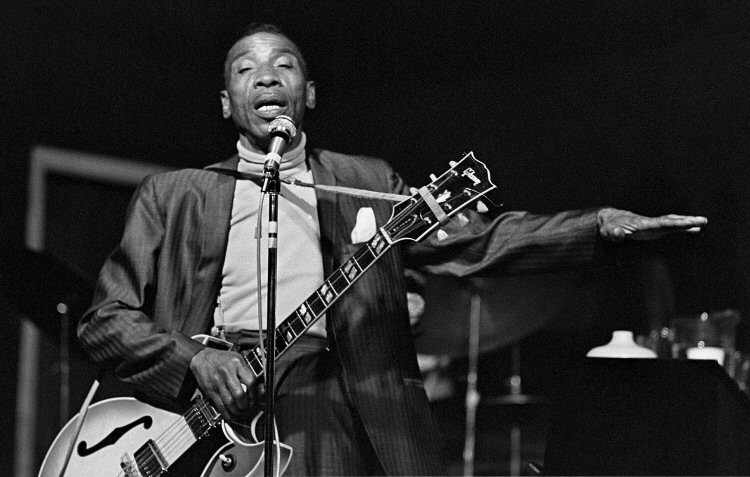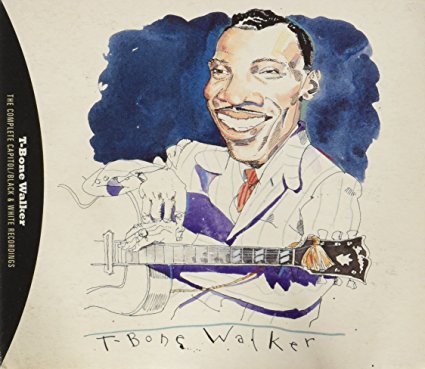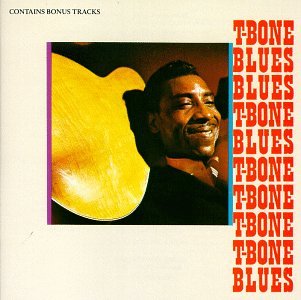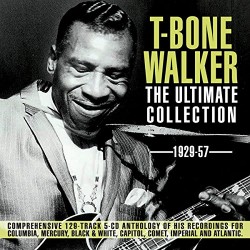
BLUES JUNCTION Productions
7343 El Camino Real
Suite 327
Atascadero, CA 93422-4697
info
- Home
- Letter From the Editor
- Tom Hyslop: A Personal Appreciation
- Top Ten Albums of 2022
- Dave's Top Ten List of Top Ten Lists
- An Appreciation of James Harman
- Album of the Year: The Duke Robillard Band They Called It Rhythm & Blues
- Album Review: Rick Holmstrom Get It!
- Album Review: The Phantom Blues Band - Blues for Breakfast
- Album Review: Bob Stroger & the Headcutters That’s My Name
- Album Review: Hash Brown - Stop! Your Evil Ways
- Archives
- Contact Us
- Links
T-Bone Walker: Re-Visited
Through the years people have walked up to me and said, “Dave, who is your favorite blues musician of all time?” I might say, “Gee, there are just so many,” which of course is true. Maybe they will phrase the question this way, “Who is the most important or the most influential blues musician of all time?” That’s easy and the truth is that it is the same person. His name is T-Bone Walker. That is the truth and not to be confused with an ‘alternative fact.’

That’s right Aaron Thibeaux Walker. Not only is T-Bone Walker a personal favorite, he is a talent without peer and the most influential musician that the blues field has ever produced.
T-Bone Walker isn’t the first person to play the electric guitar, the instrument most closely associated with the post war modern blues world, but he is one of the very first. He certainly was the first well known performer of the instrument. Up until T-Bone Walker in the blues field and Charlie Christian in jazz, the guitar, electric or otherwise, sat in the rhythm section of the orchestra. Soloing and single note phrasing on the instrument didn’t exist.
For Walker the world of improvisation was uncharted territory and as wide open as the Texas prairie in the 1930s. What he did with that landscape would change how people would come to appreciate the electric guitar and blues music forever. T-Bone Walker invented a language that is still in use today. He also was a soulful singer of extraordinary depth. The combination made Walker not only a popular performer in his day, but an enduring icon.
However, historical revisionists often exclude him from their mono-thematic storyline. I have screened otherwise fairly comprehensive documentary films covering the history of the blues which don’t make a single mention of this blues pioneer. Why? Because T-Bone Walker complicates their narrative. He confuses a generation of people who were taught that the great Muddy Waters invented electricity and that Chicago blues and blues are the same thing. In a bizarre examination of blues music it was generally thought that if British 1960’s era blues-rock musicians weren’t interested in anything outside of Chicago blues, and they weren’t, then it wasn’t worthy of American examination either.
Walker wasn’t a Chicago blues man. He was a Texan who, by the age of twenty five, was performing in the blues Mecca of Los Angeles. Once you start talking about Texas and West Coast blues the entire Chicago blues narrative finds its rightful place and becomes part of a much larger historical tableau. It becomes just part of a magnificent and of course more complicated and compelling story.
T-Bone Walker embodies all things the modern day, white blues revisionist will never understand. Walker’s uptown, swinging, sophisticated brand of blues doesn’t place the mid 20th Century American Negro where they want him. He isn’t a backwoods troubadour strumming on a front porch in the panther infested woods of the rural South. He isn’t playing in small taverns in Chicago’s south side either.
T-Bone Walker was an elegant performer who gained fame in his own time. From large dance halls in Dallas to Houston and onto Los Angeles, he was an extraordinary talent as well as innovator. He was also one of the greatest and most prolific songwriters the blues field has ever produced.
There of course is a flood of recordings, compilations and greatest hits packages available to the public, but three different career defining releases are essential entries into any blues library by the one and only T-Bone Walker. We will also discuss a forth.
Let’s start near the beginning with the three disc, seventy five track, box set The  Complete Capitol/ Black and White Recordings. Walker demonstrates that by the time he went into Capitol Records, the first record company based in Los Angeles, in 1942, he had already developed a fully realized vision of how he would present his music. On July 20, 1942, Walker cut his first single Mean Old World for the then brand new label.
Complete Capitol/ Black and White Recordings. Walker demonstrates that by the time he went into Capitol Records, the first record company based in Los Angeles, in 1942, he had already developed a fully realized vision of how he would present his music. On July 20, 1942, Walker cut his first single Mean Old World for the then brand new label.
Capitol may have been on wobbly legs back in those very early days of the label’s existence, but Walker was already on firm footing. His move to the blues and jazz label Black and White Records seemed like a natural fit and with the wunderkind Ralph Bass at the helm, Walker flourished as an artist.
It was here that Walker cut many of his most iconic sides and one that would become a blues standard. Perhaps the most recognized, recorded and beloved blues song of all time, Stormy Monday, was written and cut by Walker in 1947. This tune is the story of the life of a working class American told one day at a time and covering his life over a week’s time. Its message resonated with African-American audiences like few tunes ever written. Like most everything in Walker’s canon Stormy Monday is told through elegant and poignant imagery which is also direct and easy to understand. The song’s appeal is universal.
Other Walker standards and fundamental tunes in the blues lexicon would follow, perhaps most notably the very first recordings of the T-Bone Shuffle, Bobby Sox Blues and West Side Baby. Musical historians point to the historic nature of these recordings as a period where Walker was developing the iconic language on his guitar that would influence every blues man to pick up the instrument since. You won’t get much argument here, but to my ears Walker already sounds like he had developed his signature style by this time. These seventy five sides which include a whole host of alternate takes, laid down the template to which virtually all blues musicians owe a tremendous debt.
However, this blues titan didn’t come out of nowhere.
Aaron Thibeaux Walker was born in the small east Texas town of Linden on May 28, 1910. His famous sobriquet is the bastardization of his middle name. The maturity that he brought to those Capitol/Black and White recordings came from his days as a youth growing up in Dallas, Texas. Walker’s parents were both musicians and his stepfather was a bass player. Virtually all of his uncles played guitar or some other stringed instrument. By the time he was thirteen Walker had taken up the guitar. Young Aaron seemed to absorb every type of instrument thrust in his direction. His playing, given this type of musical background, seemed inevitable.
During this time the blues scene in Dallas was in its infancy, but one of the popular performers in the 1920’s was a Walker family friend and first generation Texas blues man, Blind Lemon Jefferson. It was young Aaron who would escort the blues musician to the various night spots in the Deep Ellum section of Dallas and watch the famous performer sing his songs and play his guitar. Walker soon became a protégé of the great blues man as he performed frequently in the Walker household.
Walker participated in family musical gatherings where he played the ukulele, mandolin and banjo as well as guitar. He absorbed the music like a sponge and even began listening to the recordings of the popular duo Leroy Carr and his guitarist Scrapper Blackwell. Walker would also attend performances by Lonnie Johnson when that guitar innovator came through Dallas.
By the time Walker was sixteen he was a full time professional musician. Singing and dancing had become part of Walker’s repertoire by this point. He even recorded a couple of sides for Columbia Records. His Trinity River Blues and Wichita Falls Blues didn’t sell particularly well so Columbia didn’t pursue an ongoing relationship with the young Texan.
As he had told interviewers through the years, he had been playing the electric guitar for a few years before his first recording using the instrument in 1939. During the early part of his successful recording career, Walker emerged as a major star in the African-American world of music. However the sales of his records were somewhat curtailed by America’s wartime rationing of shellac which was used to make 78 RPM records back in the early 40s.
The immediate post war years saw unprecedented economic growth and opportunities for African-Americans who moved west to California from primarily Texas as well as Oklahoma and Louisiana. Many found work in the burgeoning aviation manufacturing businesses which sprang up in Los Angeles and its surrounding communities during the war. T-Bone Walker was at the right time and the right place and in his prime.
He soon signed with Los Angeles based Imperial Records and began waxing sides for that label. These are included in the second essential T-Bone Walker offering. The Complete Imperial Recordings, 1950-1954 are fifty two of some of the greatest blues recordings ever produced.
Imperial Recordings, 1950-1954 are fifty two of some of the greatest blues recordings ever produced.
Sessions from mostly Los Angeles are augmented by material also recorded in New Orleans. Many of the L.A. sessions include the tenor saxophone of Maxwell Davis. He is nearly as an important figure in the development of the west coast blues sound as Walker himself. He is to L.A. what trumpeter Dave Bartholomew was to LA. It was in Cosimo Matassa’s J&M Studios in New Orleans where Walker hooked up with Bartholomew to record several sides heard here. They are joined by tenor sax man Lee Allen on many of these sides. Like the recordings from Los Angeles the best musicians in town are featured on this collection. If those towns are L.A. and New Orleans...hold on to your hat.
These tracks are bristling with energy to go along with a sort of a sublime beauty where the voice and guitar of T-Bone Walker lead the charge. Each recording is placed and annotated in chronological order based on the recording date.
While the Complete Imperial Recordings, 1950-1954 is pretty hard to top, T-Bone Walker may have done just that with his next and final indispensible series of recordings. Three different sessions from 1955-1957 are featured on the Atlantic Records 1959 release T- Bone Blues. These recordings are shockingly intimate. The sound quality and fidelity are such that it sounds like T-Bone Walker is playing on the couch next to you in your living room. His music is presented using small combos where the guitar artistry of Walker is front and center in the mix.
For the first sessions Atlantic took Walker to Chicago where he recorded, Papa Ain’t Salty and Why Not. These sessions included Jimmy Rogers on second guitar and Junior Wells on harmonica. Why Not was reworked by Rogers and made into his hit, Walking by Myself and released by Chess.
The next two sessions found Walker back in L.A. where he was joined by tenor sax great Plas Johnson as well as pianist, producer, writer and arranger Lloyd Glenn, among others. He also cuts the heads off nephew R.S. Rankin and jazz guitar great Barney Kessel on a couple of up tempo numbers, most notably Two Bones and a Pick.
Walker takes advantage of the superior sound quality brought forth by Atlantic Records  to re-record some of his best known sides from the Black and White sessions. These include The T-Bone Shuffle, Stormy Monday and others. One of my all time favorite slow blues, Evening appears here as well. T-Bone Blues might be the most overall satisfying release of his career.
to re-record some of his best known sides from the Black and White sessions. These include The T-Bone Shuffle, Stormy Monday and others. One of my all time favorite slow blues, Evening appears here as well. T-Bone Blues might be the most overall satisfying release of his career.
However by 1959 the world of pure African-American musical expression started to take some hits. Black folks as well as whites started to become distracted by other more popular forms of music. By the time the 1960’s rolled around and the British Invasion had begun the brand of music that T-Bone Walker helped to usher into the world’s consciousness had fallen out of favor with large segments of the public. His recording career was somewhat of a mixed bag at this point as well. Various labels tried to tinker with his sound in an attempt to connect the great T-Bone Walker with a new audience.
T-Bone Walker died on March 16, 1975. He was 64.
So these three seminal releases by T-Bone Walker covering 142 tracks represent the absolute cream of the crop and are the best representation of his genius.
Now to complicate things just a little...
I should point out that there is a relatively new entry into the recorded legacy of T-Bone Walker. It is the 2014 five disc box set entitled, T-Bone Walker: The Ultimate Collection 1929-1957 on the Acrobat label which I highly recommend. This box includes all of the above plus a smattering of the material he recorded with the Columbia, Comet and Mercury labels. It clocks in at 129 tracks. What is missing are the alternate takes on the Capitol/Black & White Sessions.
1929-1957 on the Acrobat label which I highly recommend. This box includes all of the above plus a smattering of the material he recorded with the Columbia, Comet and Mercury labels. It clocks in at 129 tracks. What is missing are the alternate takes on the Capitol/Black & White Sessions.
These 24 alternate takes sit beside the original versions on the Complete Capitol/Black & White Recordings and tend to bog down the listening experience to some degree. So for many, myself included, The Ultimate Collection may be the way to go. It gives listeners a complete career retrospective on Walker and his music and cuts out during his last truly great session with Atlantic in 1957. Like the three previous releases we talked about these sides are also presented chronologically.
Additionally the long out of print The Complete Capitol/ Black & White Recordings is not only hard to find, but expensive and at this point should come with an important codicil. Its shelf life is coming to an end. That’s right; it seems that the Capitol Records CDs, which are distinguished by the caricature artwork on the covers of these releases, had some serious defects in their manufacturing process. Without boring you with the details of this process and what they did wrong, the important fact is as time marches on these defects are now becoming problematic. So regardless of how much you pay for these recordings, if you can find them at all, you may not be able to listen to them anyway.
This makes The Ultimate Collection that much more attractive. The Ultimate Collection has terrific sound quality and comes with a fourteen page booklet which provides detailed information on each track including session musicians, recording location and dates along with the original catalogue numbers. The six page bio which was written by Paul Watts is adequate at best and mostly accurate.
So there you have it, four of Dave’s desert island discs. I have never stopped listening to these sides. I always find something new and beautiful to admire and enjoy every time I hear these seminal recordings. I try very hard to avoid clichés so when I say that these sides are “timeless classics” it’s not just something to say. It describes these gems with precision accuracy.
The blues sounded different before T-Bone Walker and thanks to his immense contributions as evidenced on these recordings, it has not sounded the same since. It is why T-Bone Walker is the most important and influential musician in the blues field. If you want to know the truth...he just might be my favorite as well.
- David Mac
For these and thousands more blues titles, click here:
Copyright 2022 BLUES JUNCTION Productions. All rights reserved.
BLUES JUNCTION Productions
7343 El Camino Real
Suite 327
Atascadero, CA 93422-4697
info
